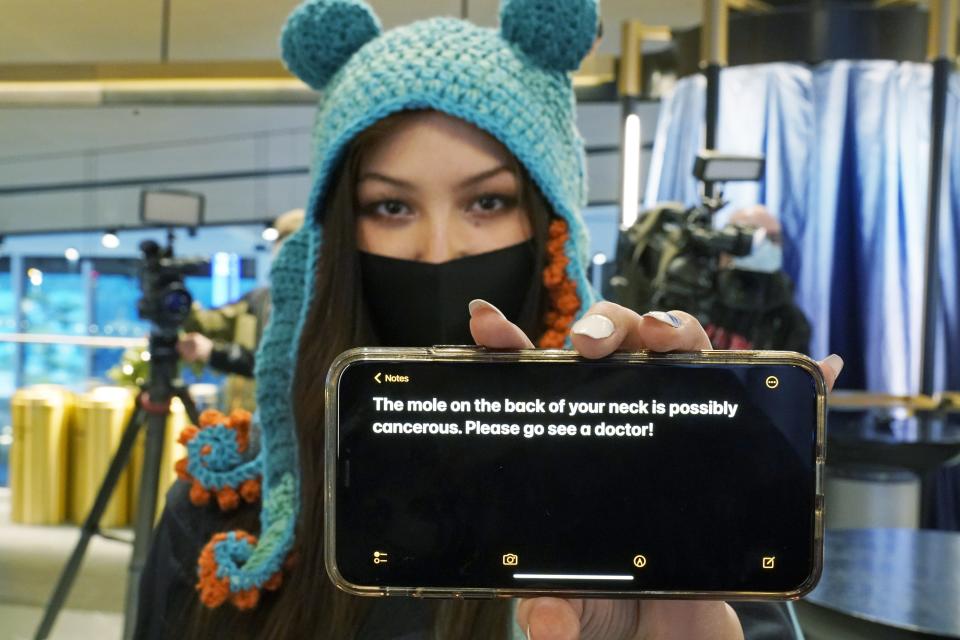Young woman's sharp eye — and persistence — saved a stranger's life
On New Year’s Day, a heartwarming skin-cancer story played out in real time over Twitter — and it originated from an unlikely source: the National Hockey League.
The story brought smiles to all who followed it — and also gives us a chance to learn more about an all-too-often deadly disease: melanoma.
Here’s how it unfolded:
On the afternoon of the Vancouver Canucks’ Jan. 1 nighttime road matchup with the Seattle Kraken, the Canucks’ Twitter account posted a long letter from longtime assistant equipment manager Brian “Red” Hamilton that read in part:
“I am trying to find a very special woman and need the hockey community’s help. To this woman I am trying to find, you changed my life, and now I want to find you to say THANK YOU SO VERY MUCH!”
The letter went on to recount how, on Oct. 23, when the Canucks played in Seattle in the brand-new franchise’s first-ever home game, an unidentified masked woman sitting behind the visitors’ bench repeatedly tried to get Hamilton’s attention between periods.
“...The message you showed me on your phone...has made a true life-changing difference for me and my family,” wrote Hamilton. “Your instincts were right and that mole on the back of my neck was a malignant melanoma and thanks to your persistence and the quick work of our doctors, it is now gone.”
Well, the social media world went to work and within a couple of hours, the woman — 22-year-old Nadia Popovici, a 2019 University of Washington grad who plans to attend medical school and whose family has season tickets behind the visitors’ bench — had been identified.

As luck would have it, she had planned on attending that night’s game. She contacted the Canucks and arrangements were made for Hamilton and her to meet.
At a pre-game Zoom press conference, both Hamilton and Popovici recalled what they were thinking on that fateful October night.
“I felt bad at the moment because I’m walking off the bench, and she put her phone up to the glass and on the phone it said the mole on the back of your neck is cancer. It threw me off,” said Hamilton. “I kind of just shrugged and kept going. My initial response when I found out was I felt bad because I felt like I didn’t really give her the time of day. I’m excited that she knows because she needs to know.”
Hamilton was told by his doctors that his melanoma “was only on the outer layer of my skin [and] hadn’t penetrated to the second layer of my skin,” at which point it would have become life-threatening.
Popovici was glad “I got to look him in the eye and hear what happened from his perspective. Imagine how jarring that is to for you to be at work and someone just kind of looks at you and says, ‘Hey, maybe go see a doctor.’ That’s not what you want to hear. So the fact that I got to see him and talk to his family members that have been really impacted by him dodging a big bullet is what’s so special.”

Popovici, who spent New Year’s Eve working at a crisis hotline, has also volunteered in hospital oncology wards and noted “I saw his [mole] and I was like, ‘Wow, that is a picture-perfect example of what a melanoma looks like.’”
During a break in the action at that night’s game, the Seattle crowd was told the story of what she had done — and that the two franchises were giving her a joint $10,000 gift toward her medical school expenses.
Like I said, a heartwarming story that brings smiles to all who hear it.
And one that also gives us a chance to learn about the most deadly form of skin cancer.
Understanding melanoma
According to the Skin Cancer Foundation (skincancer.org), around 207,000 cases of melanoma will have been diagnosed in the U.S. in 2021 and more than half of those cases will be an invasive form of the disease. More than 7,100 Americans die annually from melanoma..
“The difference between early superficial melanomas and more advanced deeper melanomas are fractions of millimeters and that is why it is imperative melanoma be caught early,” said Delray Beach dermatologist Dr. Steven Hacker. “Newer immunotherapies, not available even 20 years ago, now give hope to some patients with high-risk, advanced, potentially terminal melanoma.”

Interestingly, unlike other skin cancers, such as basal cell and squamous cell, melanoma does not necessarily have a cause-and-effect association with excessive sun exposure. Rather, noted Hacker, there is a “statistical association” between melanoma and sun damage — and having had any severe sunburns during one's lifetime increases one's risk factor for the disease.
“Melanoma can occur in non-sun exposed areas such as the feet, genitalia, toenails and fingernails,” explained Hacker. “This is why all our patients are examined in gowns from head to toe.”
Aside than the statistical correlation between melanoma and sun exposure, other potential risk factors for the disease include genetics and a family and/or patient’s history of multiple atypical moles, as well as the aforementioned severe sunburns.
Early-stage melanoma typically has several recognizable features.
These include “irregular black pigment or multiple irregular pigment areas within a spot on the skin, a bleeding lesion within a dark mole and/or irregular borders that are asymmetric” said Hacker.
Indeed, Popovici told the Seattle Times that the discoloration and asymmetry of Hamilton’s mole were among the characteristics that first caught her eye and made her think it might be melanoma.
And because none of us should count on the conscientious, well-trained eye of a complete stranger to alert us to potential skin cancers, Hacker urged that “you see your dermatologist once a year at a minimum and do not wait if you see an irregular pigmented lesion on your skin.”
This article originally appeared on Palm Beach Post: sharp-eyed-hockey-fan-caught-equipment-manager's-skin-cancer

